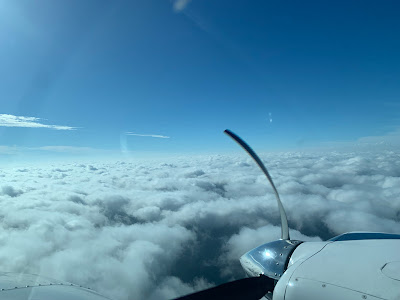I had planned to just drop by the plane to do some cleaning but when I arrived I took another look at the weather and couldn't resist the training opportunity. Today was a perfect day to shoot approaches and practice with the radar. There was a line of storms moving in and as I sat in the hangar it was about 130 miles out.
I was a bit low on gas, only 3 hours, so I decided to start with a practice approach and top off. I headed to 28J and shot the GPS 27 through some bumpy clouds breaking out at 1600 for an easy arrival. After topping off, I picked up my clearance on the ground and was quickly released. My plan was to fly to OTK (Valdosta VOR) and then turn around and come home. By the time I was back in the air, the storms had moved much closer to OTK so I wouldn't have to go as far to practice with the radar.
I have been very happy with the addition of onboard radar to my bag of tools and on several trips it has really made a difference and allowed us to travel through areas of convective weather safely. Today was not one of those days. Even though radar gives you the real time information to safely avoid severe weather, today there was no safe path to find. It did provide some good practice though.
This was a significant line and was actually easy to image at 100 miles. The physical horizon was 95 miles out at my 8000 foot altitude. I started with a 0 tilt and you can see the ground clutter as the beam reflects back until around 75 miles where the angle of incidence is not great enough to reflect back.
I prefer a 2 degree up tilt at this range. You pick up less clutter but the core of your beam is still hitting the storms at the critical levels.
I requested a re-route and was cleared direct Taylors which was a safer heading. You can see the smaller storms starting to form to the left of my old course.
Just before I got to Taylors I did a bit of vertical profiling. I had that big cell about 60 miles out
Here is the vertical shot. I was at 7k and my beam was angled up 3 degrees so doing some math, the blue line intersects the storm at around 25k, The tops are painting around 35k.
Also notice how the ground clutter is pretty symmetrical but the storm is clearly vertical. Here it is again about 7 miles closer. Notice that since I am not heading directly at the storm I am now pointing at a different slice of sky and it has a slightly different structure.
After making the turn at Taylors, I went from dark to blue skies. Home was calling for 1800 overcast so I had to be sequenced for the ILS 32, circle to 23. The controller had held me high and then given me a steep descent. I also had about 20 knots of tailwind up high so when he requested that I drop my groundspeed to 170 and then 150 I replied with unable. I told him I could as soon as I was level.












No comments:
Post a Comment